
Book Excerpt: Savoring The Noatak River

Jon Waterman has seen the raw beauty of Alaska and understands that for future generations it is under siege. Waterman once had a career as a mountaineering ranger at Denali National Park some 40 years ago. Some of the most thrilling times of his life were spent further north in Alaska, including exploring Gates of the Arctic National Park and the wild Noatak River that runs through it.
In 2021, he returned to those Alaska backcountry lands with his son, and Waterman’s conclusions about climate change’s effects on the terrain prompted him to write first a New York Times editorial piece and now a lengthy book on the Alaska he once knew and how it could be changing now and well into the future.
“I had never been anywhere like it,” Waterman writes in his soon-to-be-released Into The Thaw when describing an August 1983 Noatak adventure with ranger Dave Buchanan. “We were surrounded by snowy peaks that could have been a mile or perhaps 5 miles off and – when we pulled our paddles out of the river to listen – the aqua-blue Noatak River tittered against the hull of our tandem kayak with unseen and minuscule grains of silt washed down from glaciers hidden above.”
Waterman and Buchanan would follow wolves, share camp with a grizzly and catch the grayling they would eat on pristine Lake Matcharak, a sacred place that Waterman discovered had churned out fish long before his time. He can’t help but wonder for how long that legacy will continue.
The following is excerpted from Into the Thaw: Witnessing Wonder Amid the Arctic Climate Crisis, by Jon Waterman. Reprinted with permission by publisher Patagonia.
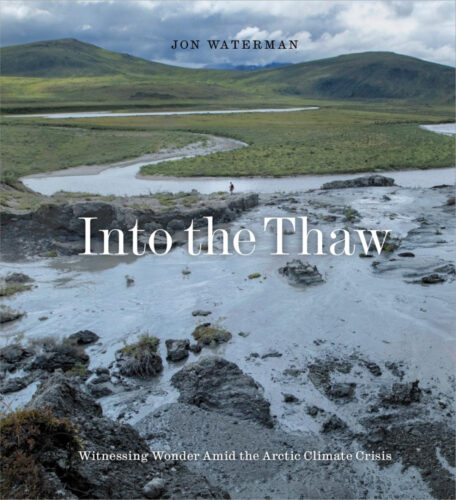
BY JON WATERMAN
In rivers or lakes (caribou’s) hooves become flippers (while their body’s guard hairs are hollow and buoyant
in the water). By fall the callused parts of their hooves have been worn down by rocks and the soft pads have lost their hair as the hooves widen for more surface area across wet permafrost bogs. In winter, their hooves harden again on the outside and soften on the inside with a new growth of hair to insulate them from the cold. Then they use their concave hooves as shovels to dig through the snow for lichen.
The velvet skin that coats their antlers holds blood vessels that allow caribou to cool their body temperature in the heat of summer. Within weeks the bulls that clattered alongside us on the Noatak would shed their antlers. In spring, as daylight returned, their antlers would grow back at an inch a day.
All this animal activity amid such a primeval place put me into a new, instinctual level of awareness, along with the sensation that we had been transported into an earlier world. Like that of Lewis and Clark upon their Missouri, surrounded by a horizon of bison.
The tundra around us had reddened with frost. My toes felt numb inside neoprene socks. And I couldn’t help but notice – as Dave had repeatedly pointed out – that only two days out and the polypropylene T-shirt beneath my fleece jacket emitted the soured, plastic-bag smell unique to 1980s synthetic clothing.
Then Dave whispered, “Wolf,” and pointed to the left bank where a black wolf sat regally on its haunches, gone still as a statue, steadfast in its stare as if to critique our paddle strokes.
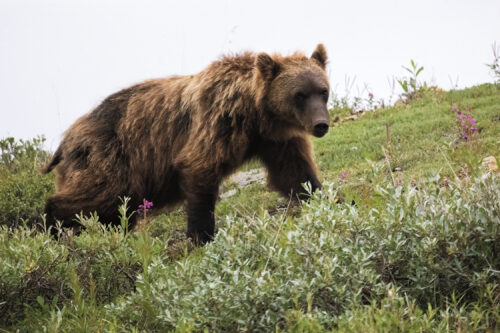
From my journal:
We paddle slowly for the shore and to our amazement, the wolf waits for us. So, we carefully look down at the ground and only steal peripheral glances his way as if eye contact will show too much dominance and violate the rules here in the high kingdom of animalia. As we step out of the boat the wolf backs off into the willows, yet slowly, not really fleeing so much as inviting us to follow. So, we follow through chest-high willows. Each time I raise my camera the camera-shy wolf jumps behind another willow. Somehow, he is not afraid and carries himself with dignity. He ducks behind the willows two more times and each time I lower my camera until he reappears atop an old glacial esker out in the open.
He sidles along in a diagonal lope with his rear feet hitting the tundra to the side of his front feet, instead of moving straight ahead. Now that he’s out in the open we can see – unlike the muscular blonde wolf of this morning – that this black wolf has a gimpy rear leg, as if he’d been kicked by a caribou. His ribs poke out through gray fur. Still, there’s spring to his steps.
We chase our conceit that this wolf will lead us somewhere important, and sure enough, on a nearby riverbank we hear mewing noises. Then the old gray-black wolf begins to lope south abandoning its diagonal sidle, as if its mission is now accomplished. So, we push through waist-high willows for thirty yards and suddenly find ourselves in a clearing with the sandy wolf of the morning – who jumps down from her family at the den and sprints for the river.
“Jeez, Jon!”
“My god,” I reply.
There are five pups lying in the sand next to the hole of their den. Most are asleep; one looks up at us from the leg bone of a caribou and tilts its head with curiosity at us, then slowly stands and walks away while its siblings remain asleep.
We crawl closer; their fur riffles in the wind.
“Don’t touch anything,” Dave whispers. “Don’t want to foul it with our scent.”
At this the other pups yawn and stretch; one licks its paws. From the river below comes a howl from their mother, rising sharply, until it breaks into its third and final note after twenty seconds as she strains for more volume:
Owwwwwww—wwwwwwwwwww-WOOOO.
At this, all five of the pups immediately stand up: 25-pound tawny, cinnamon-colored furballs who stumble atop uncertain legs down off the den hill toward their howling mother. Rather than further violate their sanctity by chasing them, we take a photograph of the 8-foot den hole and leave, still not speaking above a whisper. Like being in church.
We beat our way back to the kayak past bearberry and crowberry and mountain cranberry, all brightly advertising their wares in an acerbic sweet fermentation. All the way we hear the seductive echo of the mother wolf’s three-noted croon telling her pups to “come away, come away, come away.”
How could the hair not rise up on the back of my neck?
We lift, then shove the big kayak into the river, and slide into our cockpits with paddles behind our backs braced across the thwarts to prevent snapping the wooden crossbars. I cup a hand to drink from the river.
At the next bend we see all the pups swim the river with their muzzles held high and tails that work the current like rudders. We back-paddle to give them space and watch the pups climb out one by one. As the last skinny pup – maybe the runt of the litter – comes up out onto the silt bank a beat slower than his siblings, his legs are sucked down into the glacial till and he begins to whimper. He’s trapped.
While the blonde mother sits still in the reddening tussocks above, refusing to look at us, we drift closer. As the trapped pup begins to whine, Dave and I look at one another with the same question on our minds: Should we rescue it? Before we can paddle over to the bank, two
other pups run down and bite into their brother’s neck fur, then with three tremendous pulls tug of war – they yank him out of the silt-like quicksand, growling and play-biting one another with their little needle teeth. The mother then leads all five off up onto the tundra bench. No one looks back at us and we watch only with sidelong glances to respect their privacy.
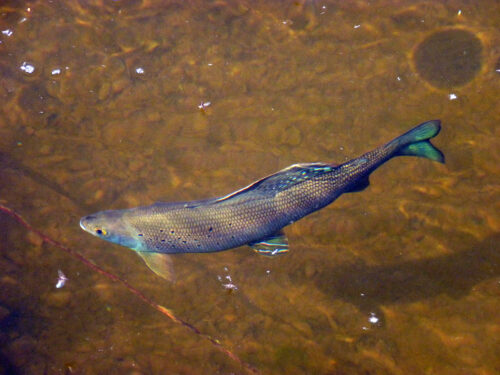
THAT EVENING WE MADE camp on an open sandbar. While we strolled a high bank downstream, we spotted a distant grizzly bear on the tundra. So with the stealth and deference for a creature above us on the food chain, we crawled on hands and knees up to an old glacial esker and laid down on top of the ridge 100 yards from the grizzly. The binoculars revealed the details.
The grizzly sat atop the remains of what resembled a large bull caribou. The bear periodically lowered its bloodied muzzle into the bowels of the dead caribou and tore out its intestines.
Although the two animals were in ankle-to-knee-high dwarf birch and miniature tundra plants, the kill site looked like a bulldozer had cleared it to bare soil around the kill. You could just imagine the 600-pound, muscle-bound bear as it lifted the big caribou off the ground and flung it around to break its neck before disembowelment began.
On the sidelines sat a fox and a dozen ravens. At one point the fox crept in closer and the bear stood up and made a quick head feint – with all the adroitness of a point guard’s head fake toward the net – and the fox darted away with tail between its legs as the birds rose in the air and settled back down again as if they had just ridden the crest of an ocean wave.
We, too, got the message and crept away. Dave asked why we had gotten so close to a grizzly on a kill, particularly with the shotgun back in the kayak. Grizzlies are the black holes of the Arctic universe, dominant force fields that absorb everything – leaves, grass, blueberries, roots, ground squirrels or large-hooved animals – that enter their orbits. At the same time, however, the presence of grizzlies – that need several hundred square miles to survive – showed us that the establishment of this park landscape had unequivocally succeeded. Still, I had a lot to learn about grizzlies.

WE REACHED THE FLOATPLANE takeout at Lake Matcharak the next day, folded up our Folbot, hauled it a half mile to the lakeshore across a field of unstable tussocks, mercifully free of mosquitoes, and set up camp.
There were no jet contrails in the sky. And I couldn’t get over the pressure of light against my face. I remember how I stared at it aglow on my hands.
The evening light flowed like viscous liquid into the tent and set the sedges afire as if the wind carried a molten wave. It painted whitecaps on the lake, colored the snowbound peaks pink, and lit clouds into brigantines of fire.
“You going to catch dinner?” Dave asked.
“I’ll try,” I replied.
The Alaskan myth of a fish on every cast comes close to the truth in the Arctic. In five casts, I caught two grayling. Compared to the more pensive salmon, grayling hit and run like underwater bandits and bend your rod double.
I cleaned the fish in the water with my Swiss Army knife and threw all but the filets out into the water where a bear wouldn’t smell them. Then we sat 50 yards from the tent, torched the stove, and sautéed the firm white flesh – scales down – until it curled and cupped in the frypan. As we picked a few small bones out of our mouths and threw them into the lake, we knew we weren’t the first to give thanks to grayling on this sandy shore.
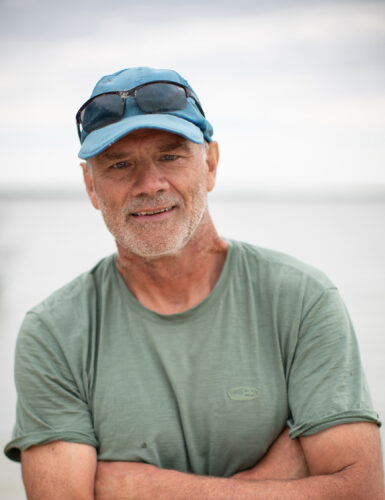
AS EARLY AS 6,000 years ago – more than a millennia before the Egyptians began to build the pyramids – the ancients fished and hunted alongside the pure-blue, cloud-reflective waters of Lake Matcharak. Known to modern archaeologists as the Northern Archaic culture, followed by the Arctic Small Tool tradition (ASTt), named for the arrows and spearpoints minutely and carefully chipped from obsidian and chert, these hardy Iñupiat predecessors depended upon the caribou. The Canadian archaeologist Robert McGhee called them Palaeo-Eskimos, with no definitive link to the Inuit or Iñupiat (Eskimos) who succeeded them several thousand years later. Although their tools, hunt techniques and houses mostly proved different from the more modern-day inhabitants of the Arctic, McGhee believed that they invented the igloo.
“The Palaeo-Eskimos provide an example of lives lived richly and joyfully amid dangers and insecurities that are beyond the imagination of the present world,” wrote McGhee in his book Ancient People of the Arctic.
Park service workers dug out and sifted hundreds of thousands of animal bones and chipped-stone tools. Blades, burins and scrapers were buried in the sand and frozen in the permafrost alongside the lake. Archaeologists have not found another Alaskan ASTt site that comes close to the number of ancient animal bones found at Matcharak. Most of the bones were caribou, hunted and butchered in summer, then eaten and used for clothes, skin-tent shelters, and tools. There were also the remains of Dall sheep and ground squirrel bones. Since no large wood was available, they had fastened their microblade chert and obsidian points into caribou-bone handles or spears.
Despite the hostile, cold environment and the lack of comfort or security in a hard world where the rivers and sea completely froze over, these caribou people designed caribou-bone tools with etched lines and artistic grace. Their carefully and slowly carved tools spoke of aesthetic sensibilities and a belief in a higher life beyond the brutal day-to-day realities of survival.
In little more than a couple of centuries, like-minded, artistically inclined hunter nomads from Western Alaska migrated and eventually colonized all the Arctic. Given the iron-cold winters and short summers, it’s hard to imagine the ingenuity and toughness it took for these people to prosper amid hard-to-catch animals and the frozen aridity of the North. They lived short lives.
They journeyed with their shaman leaders from Alaska more than 2,000 miles east to Greenland in animal-skin boats. One of the earliest pieces of ASTt masks ever found – a 3,500-year-old, miniature mask portrait of these colonizers – was found in Eastern Canada. The tattooed face, McGhee said, “emanates tranquility and grace.”
Less than 1,000 years later, pre-Dorset people subsumed the old culture. They hunted marine mammals, developed the dogsled and seal oil soapstone lamps, and continued to carve several-inch-long stone masks that depicted serene, half-animal, half-human faces.
Andrew Tremayne – one of the archaeologists who uncovered the remains at Matcharak and returned to the site for several summers – once held the tiny projectile points in his hand in wonderment. Since the earliest evidence of bow and arrow use belongs to the ASTt (and the tool likely came from Asia across the Bering Land Bridge), the projectile points could’ve been from arrows, or even spear darts from atlatls (spear throwers). He had seen stone tools from many time periods, but at Matcharak the ancients had taken the time and trouble to intricately flake even the smallest blades with a unique combination of artistic expression and tool function. Fascinated, Tremayne replicated the tools and found that even a tiny spall-flake proved incredibly durable and could cut or score animal bones.
“The level of craftsmanship on even their tiniest stone tools implies a great appreciation for the aesthetic value of the objects they produced,” Tremayne said. “If their spiritual beliefs and stories are anything like the tools they made, this part of their culture would have been very intricate and beautiful. I often think they must have been the toughest people to have ever lived on Earth.”
As would be true with the Iñupiat who followed in their footsteps. Tremayne believes that the ASTt speared their grayling and may have created three-pronged tridents or weighted nets used by latter-day fishermen. Since the ancient inland peoples’ tools were so tiny, the Iñupiat who now fish on the coast will ask Brooks Range travelers if they’ve seen any sign of the “little people.”
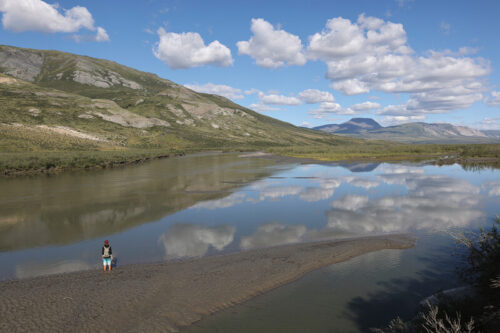
DAVE BUCHANAN AND I went to sleep that night with grayling in our stomachs, beneath stars that winked and blinked light with all the phosphorescent sparkle of bioluminescent organisms in a blackened ocean. We looked forward to the next day’s floatplane.
We would be whisked back to the ranger station in Bettles, Alaska, into warm rooms with cold beer and a meal that we would heat in a microwave. Our casual patrol was a far cry from the hazard-filled journey that the ancients took in their caribou robes as they paddled and walked several hundred miles back to the sea thousands of years ago. ASJ
Editor’s note: Into the Thaw: Witnessing Wonder Amid the Arctic Climate Crisis, is set to publish on October 22 and will be available for purchase at https://www.patagonia.com/product/into-the-thaw-witnessing-wonder-amid-the-arctic-climate-crisis/BK915.html. For more on the author, check out his website at jonathanwaterman.com.



